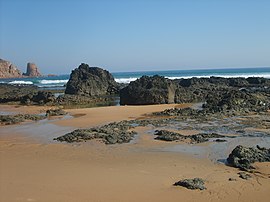Cape Woolamai, Victoria
|
Cape Woolamai Victoria |
|||||||||||||
|---|---|---|---|---|---|---|---|---|---|---|---|---|---|

The rocks and rockpools at Cape Woolamai Surf Beach
|
|||||||||||||
| Coordinates | 38°31′34″S 145°20′13″E / 38.52611°S 145.33694°ECoordinates: 38°31′34″S 145°20′13″E / 38.52611°S 145.33694°E | ||||||||||||
| Population | 1,232 (2006 census) | ||||||||||||
| Established | 1959 | ||||||||||||
| Postcode(s) | 3925 | ||||||||||||
| Location | 140 km (87 mi) from Melbourne | ||||||||||||
| LGA(s) | Bass Coast Shire | ||||||||||||
| State electorate(s) | Bass | ||||||||||||
| Federal Division(s) | Flinders | ||||||||||||
|
|||||||||||||
Cape Woolamai is a small town and headland at the south eastern tip of Phillip Island in Victoria, Australia. It is home to Cape Woolamai State Faunal Reserve, and the Phillip Island Airport. Cape Woolamai contains a subdivision also called Cape Woolamai (formerly known as Woolamai Waters and Woolamai Waters West).
The cape was named by George Bass (but spelt "Wollamai") when he passed it on his whaleboat voyage in early 1798.Wollamai is the snapper fish (Pagrus auratus) in the language of the Eora aboriginal people of Port Jackson, where the fish is found. Bass, who had learnt some of the Sydney language from the Eora leader Bennelong,) thought the headland resembled the head of that fish.
In 1826, during the establishment of Fort Dumaresq, near Rhyll, coal was reported to have been found in the vicinity of the Cape.
The area was purchased from the government in 1868 by John Cleeland, sea captain, publican and owner of the Melbourne Cup winner of 1875, 'Wollomai'. He then built Wollomai House, and ran merino sheep from New South Wales. In 1910 his son, John Blake Cleeland, noticed the sand was shifting due to erosion so he planted rows of Marram grass, still evident today.
In 1959, 230 acres (0.93 km2) of farmland was sold and subdivided into housing estates for beach shacks and holiday makers. It was then named ' Woolamai Waters and Woolamai Waters West ', and later renamed ' Cape Woolamai '. Cape Woolamai had a Post Office from 1970 to (probably) 1974 which was open only during summer. A Woolamai Post Office was open from 1911 until 1974. The roads were sealed in the late 1980s and beach shacks gradually turned into more substantial houses. Today Cape Woolamai has a world-renowned surf beach, Woolamai Beach Surf Life Saving Club, and a popular Safety Beach.
...
Wikipedia

